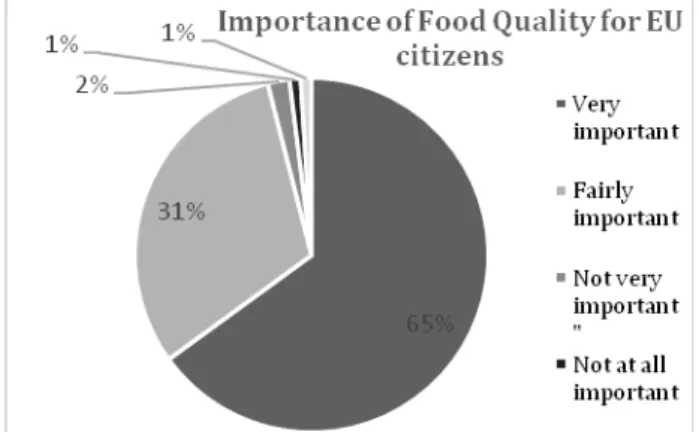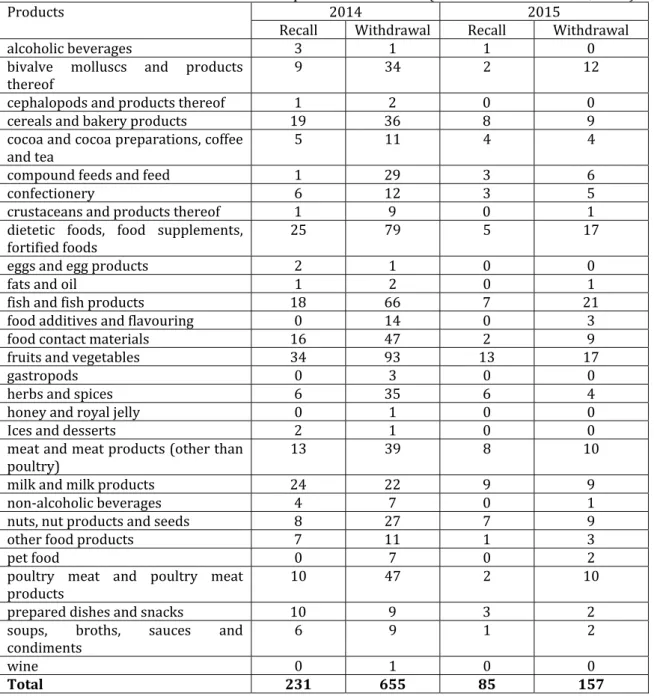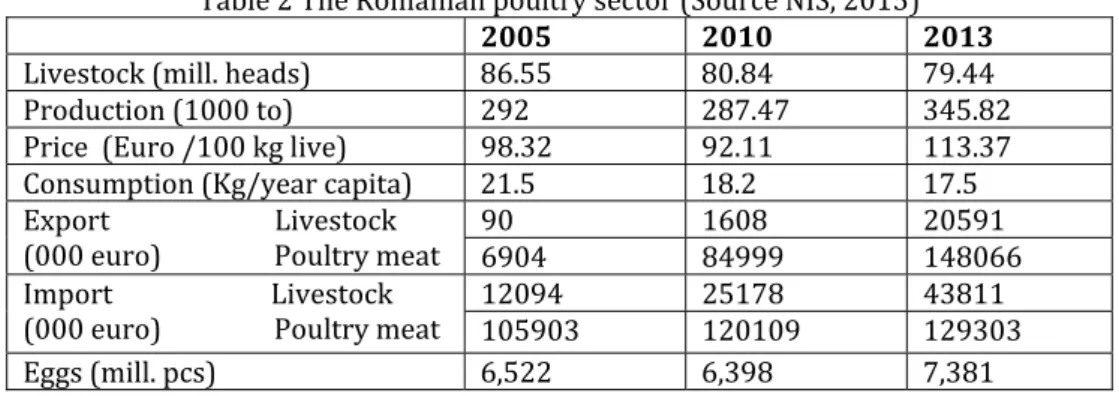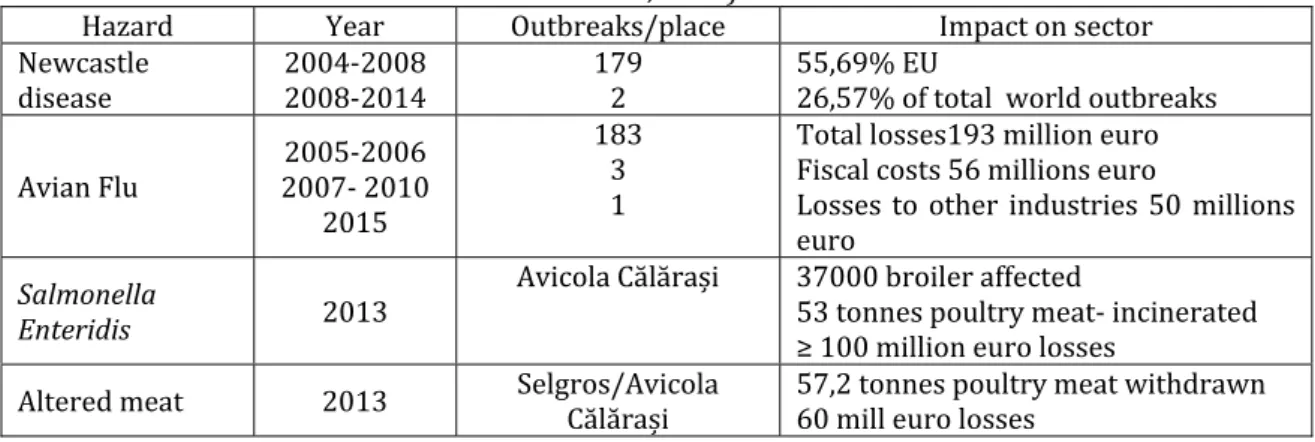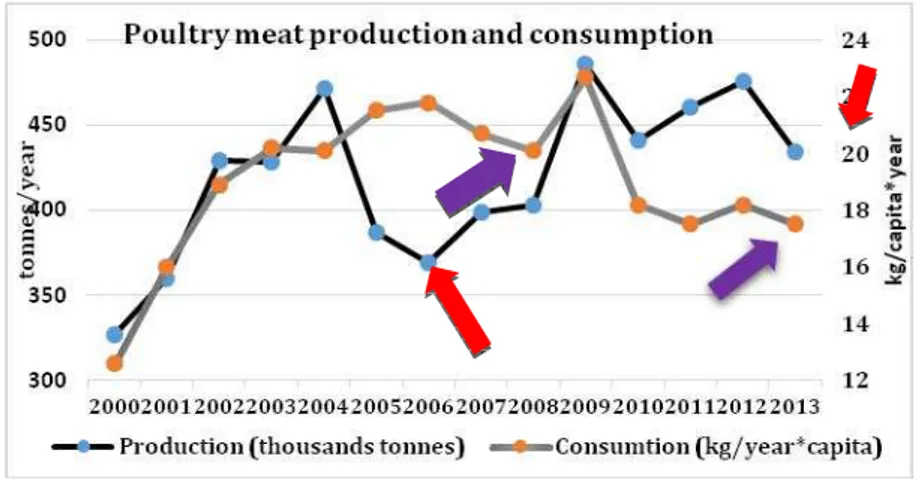FOOD CONSUMPTION AND SAFETY INCIDENTS IN ROMANIA
Silvius Stanciu
sstanciu@ugal.roDunărea de Jos University of Galati, Romania
The Bucharest University of Economic Studies, Romania
The present paper proposes an analysis of the Avian and Swine Flu s effects on meat consumption in Romania. The intense media coverage of the two epidemics, the considerable funds allocated to population vaccination and disease eradication, the duration of the outbreak make the two diseases comparable in point of duration and spreading. The research highlighted a major effect of the Avian Flu on poultry meat consumption on the Romanian market, although the shock was a temporary one, as poultry meat consumption came back to its initial values in a short period of time. The Swine Flu didn t have a significant impact on the number of animals or on pork consumption. Both epidemics led to important financial losses. The sums allocated for disease eradication came from government contributions or from financial aids provided by the World Bank or the EU.
Keywords: food, consumption, safety, incidents
JEL Code: E , M , Q
Introduction
Local food production has lately been affected by a number of events belonging to the category of food safety incidents. Food safety is a concept according to which a prepared and/or consumed food product must not harm the consumer. The terms associated with food safety are danger and risk. Food safety is connected to danger occurrence and does not include other human health aspects. A food safety danger may be a biological, chemical or physical agent present in the food product or a certain state of the product, which may have a negative impact on the consumer s health. The risk represents a combination of danger occurrence probability or danger exposure and the seriousness of the injury/disease, which may be caused by an event or by the exposure to an event. The notification represents a written document addressed to a competent authority in view of informing it about certain actions that were performed or are going to be performed, or a document written by the supplier by means of which he announces the people from the network in which the non-compliant/potentially unsafe products were distributed, that they must withdraw the respective products from the market.
Product withdrawal from the market represents any measure by means of which a potentially unsafe product is prevented from entering the market in the distribution chain. )n the food domain, all types of products, which are delivered by suppliers or obtained in own production, can be withdrawn. Product recall represents any type of measure whose purpose is the return of a product that was already given to the end user. Both measures are applied when the product that is going to be marketed or that is already on the stores shelves presents any type of nonconformities and/or has a harmful potential for the consumer. The recall involves communication with the end user. The withdrawal/recall time represents the time period between making the withdrawal/recall and finishing the action.
The legislation in the food safety domain in Romania is aligned with that of the European Union EU , ensuring a high consumer safety and health protection insurance. The EU officials support the European consumers by means of the legislative framework and of some market surveillance bodies, associated with the national systems of the member states.
Materials and methods
veterinary medicine. The EU, Romanian government or government body official press releases were useful in understanding and analysing the collected statistical data. The media information were cautiously used and we used only verifiable sources.
Figure . EU Consumers priorities in buying food Source EC - Euro barometer,
The survey regarding the Europeans attitudes towards food security, food quality and the countryside, carried out by TNS Opinion & Social, at the request of the European Commission EC , on
a sample of , respondents, leads to interesting information regarding food quality perception
and importance for the European consumer. Thus, the quality and the price are important criteria in point of percentage in food purchase decisions, being appreciated by % and % of the respondents. The origin or the brand of the product, although taken into account at the moment of the purchase, are less important as compared to the previous criteria figure . For most European citizens, the quality
of the food products is the most important factor in the purchase process, the great majority %
considering it important % or extremely important % Figure . For % of the Romanian
consumers, quality perception is a very important criterion when purchasing food, exceeding the
European average EC – Eurobarometer, .
Figure . Food quality perception for European consumers Source EC - Eurobarometer,
Another useful tool in ensuring the quality and safety of the food marketed on the Community
market is the Rapid Alert System for Fodder and Food RASFF . Thus, in , there were
products withdrawn from the Community market, their distribution being restricted by the notifying country.
The situation of the recall and withdrawal products from the Community market between
- is presented in table . The products frequently eliminated from the market are:
Fruits and vegetables, affected by the presence of some chemical pesticides, insecticides , microbiological mycotoxins contaminants or by the infection with dangerous microorganisms; dietetic foods, food supplements, fortified foods, refused for the use of unauthorised substances or inappropriate treatments;
animal products meat, poultry meat, fish – the presence of some pathogenic microorganisms or of some chemical or microbiological pollutants.
)n a top of the markets on which the most products were refused, Romania is on the last places.
Consequently, in , only one product batch was withdrawn from the market – sunflower seeds with
a level of aflatoxin above legal limits, but there weren t any product recalls. Customs control was efficient or the market assessment measures were too permissive.
Food safety incidents on the Romanian market
The last few years recorded a series of food safety problems at the European level, which also affected the Romanian food market. The most known food incidents were the epidemics that affected the meat or milk production sector, animal products. The potential for the transmission of germs to the human consumer increased the reluctance regarding the consumption of these products. (aving wide media coverage, sometimes without a thorough scientific basis, in many situations commercial or rating increase were followed and not scientific elements. The unadvised consumer was influenced by this information, which led to a decrease in consumption and to desperate attempts of some company managers to save their business, including direct consumption of the incriminated foods.
Table . Recalled and withdrawn food products - source EC -RASFF Portal,
Products
Recall Withdrawal Recall Withdrawal
alcoholic beverages
bivalve molluscs and products thereof
cephalopods and products thereof cereals and bakery products
cocoa and cocoa preparations, coffee and tea
compound feeds and feed confectionery
crustaceans and products thereof dietetic foods, food supplements, fortified foods
eggs and egg products fats and oil
fish and fish products food additives and flavouring food contact materials fruits and vegetables gastropods
herbs and spices honey and royal jelly )ces and desserts
meat and meat products other than poultry
milk and milk products non-alcoholic beverages nuts, nut products and seeds other food products
pet food
poultry meat and poultry meat products
prepared dishes and snacks
soups, broths, sauces and
condiments wine
The most affected sector was that of animal production, in which there were more frequent incidents food frauds, the presence of some contaminants, the contamination with pathogenic microorganisms , followed by the meat or milk industry. The potential of some viruses to infect humans increased the impact of these critical situations.
The poultry sector
Poultry raising is one of the most dynamic sectors of domestic meat production, which, during
the last years, succeeded in shrinking the gap recorded in the period – as compared to
Community competition. With over . million small farms, the great majority being subsistence farms, representing almost % of the total number of farms recorded at the EU level, the local avian sector
has the greatest number of units with under , broilers and only . % of the total number of large
farms. The great development recorded by the sector, which in succeeded in balancing poultry
meat foreign trade is due to some modern units that implemented an integrated production system
with fodder factories, poultry raising farms, processing units and distribution systems Van, .
The technical performances recorded by the sector in placed the local poultry sector on the
fourth place in the world and on the third place in Europe AM PNDR, . Almost % of the local
poultry market is owned by companies such as Transavia, Ave Grup, Avicola Buzău or Avicola Bacău. The increase in end product added value for these companies is achieved not only by slaughter, packaging and conservation processes of the poultry raised in own farms, but also by means of secondary processing and some processed meat products or of ready to eat/ready to meal products. The most important poultry companies developed own brands, differentiated for poultry meat production and highly processed products.
The poultry sector was affected by a number of incidents, which reduced the growth rate and
the number of poultry, which reached in the level from MADR, . The subsidy
reduction for the poultry sector producers . lei/slaughtered head for poultry bigger than kg. , in accordance with the Common Agriculture Politics, slowed down the development of the sector
Dimache, .
A synthesis of the data regarding poultry meat production and consumption in Romania is presented in table .
Table The Romanian poultry sector Source N)S,
2005 2010 2013
Livestock mill. heads . . .
Production to . .
Price Euro / kg live . . .
Consumption Kg/year capita . . .
Export Livestock euro Poultry meat )mport Livestock
euro Poultry meat
Eggs mill. pcs , , ,
Egg production is mostly for domestic consumption, covering almost % of the demand on the market. Romania imports large quantities of livestock especially from the Netherlands , which are afterwards raised in specialised farms. The imports may represent potential risk factors for the local livestock; this is why the year led to restrictions regarding livestock import from risk-prone
areas NSVFSA, .
Food Safety incidents in the Romanian poultry sector
The global animal epidemics affected the domestic poultry sector, causing considerable losses to Romanian farmers and a significant decrease of poultry meat consumption. Although the epidemics became manifest on a short period of time, the impact on the consumer was an important one. The main critical situations, which have been recorded lately in the poultry sector from Romania are
presented in table . The period – was characterised by the virulent manifestation of the
Avian Flu. counties from Romania and million livestock were affected. The epidemics led to an
action plan drawn up by the authorities NSVFSA, and an aid plan supported by the World Bank,
worth approximately million euros World Bank, . The action plan led to the eradication of the
were transited by migratory birds NSVFSA, . The last Avian Flu notification, transmitted to the
World Organisation of Animal (ealth O)E targeted a pelican colony from the Danube Delta,
without affecting the poultry.
Table Major disruptions in the Romanian poultry sector source NSVFSA, ; O)E, , World
Bank,
)f the Avian Flu becomes only sporadically manifest at present in Europe, becoming endemic only for wild birds from )taly, lately the pseudo-avian influenza has become widespread the Newcastle
disease . )t affects the world and Romanian poultry farms. Out of the outbreaks recorded globally,
in Europe there have been affected farms, out of which more than half were recorded in Romania
during the period – . Although it can be transmitted to humans, it doesn t lead to the death
of the infected people. )n the case of birds, the epidemics is extremely virulent, with a high degree of morbidity, with a death rate of over %, affecting the number of livestock, the meat and egg
production and the trade with these products because of the restrictions imposed NSVFSA, . )n
the period – there were only two farms where the epidemics became manifest. The incident
from affected only the population from the county of Brașov, with dead poultry, whereas the
epidemics led to the death of over , poultry from a farm in the )alomita county.
The poultry meat infestation with Salmonella Enteridis became manifest in , the climax of
the crisis being recorded in March and October-November. The identification of , Salmonella
contaminated poultry at a poultry farm from Călărași led to the slaughter of the , poultry and the
incineration of over , tonnes of poultry meat NSVFSA, . The estimated losses exceed
million euro.
Table . The results of the survey regarding altered poultry meat and food safety Source )RES,
Question YES NO ) don t know/) don t answer/) don t have sufficient information
(ave you heard about the altered poultry
meat scandal? % %
Do you know the name of the meat
producer? % % ) don t know the producer % ) know the region of origin but
(ave you changed your poultry meat
consumption habits? %
The refusal to purchase poultry meat from
butcher shops %
(igher awareness at purchase %
Are you interested in food safety? % % -
Do you have a good opinion about the
NSVFSA s activity? %
% heard about NSVFSA
% consider that it performs its duties well % would confidently call for the services of the institution
The altered meat scandal began after the refusal of some inappropriate meat batches by
Selgros, in the period September – October . The delivery was made by some units Avicola
Călărași. There were also some tax evasion and corruption suspicions of the officials Severin, ;
Alexe, . The high media coverage and consumption reduction are also highlighted by the study
carried out by the Romanian )nstitute for Strategy and Evaluation , by means of which the
Romanians perception about the events connected with the altered poultry meat, the food
(azard Year Outbreaks/place )mpact on sector
Newcastle
disease -- , % EU , % of total world outbreaks
Avian Flu -
-Total losses million euro
Fiscal costs millions euro
Losses to other industries millions euro
Salmonella Enteridis
Avicola Călărași broiler affected
tonnes poultry meat- incinerated
≥ million euro losses
consumption behaviours and the degree of information regarding food safety were assessed. The
survey was conducted in the period - November , immediately after the scandal started. The
survey was made by phone and the method used was CAT), a representative national multi-layered
sample made up of , individuals aged over , with a maximum tolerated error of ± , % )RES,
.
The impact on poultry meat consumption
The results of the survey, schematically presented in table , highlighted a decrease in poultry meat consumption, in Romania s food network trust and in NSVFSA s activity. The impact of these food safety incidents are also stressed by the consumption and production trends presented in figure .
Figure . Poultry meat production and consumption data Source N)S,
The presented incidents mainly affected poultry meat production, the impact on consumption being relatively delayed and cumulated with the financial crisis effects.
The pork sector
Pork is a type of meat that is traditionally consumed in Romania. A synthesis of the main indicators regarding pork production is presented in table .
Table . Pork production and consumption in Romania Source N)S,
2005 2010 2012 2013
Livestock heads , ,
Production tonnes
Consumption Kg/year
capita . . . .
, , , ,
)mport euro Livestock
Pork , , ,
, , , , , , , ,
Export euro
Livestock
Pork , , ,
According to the data presented in the table, one may notice that the pig breeding sector goes through a period of crisis determined by the decrease in the number of pigs, without the proportional decrease in pork production, which compensated by a weight gain of the pigs carcases at slaughter. Romania imports important pork quantities and exports live pigs, because it doesn t have the necessary capacity and technology of the intensive weight gaining systems up tot the optimum slaughter capacity. Pork import in Romania proves that this sector has a good outlet and measures must be taken to support and balance trade.
With the exception of the year , in which maximum pork consumption was recorded, the
African swine fever at domestic or wild animals, such cases not being recorded. Beginning with , there were no classical cases of swine fever because farm or household animals were vaccinated.
The classical swine fever CSF became manifest from and in Romania, eradication
measures being taken by vaccinating domestic or wild animals and people with high risk of getting the disease.
The outbreaks situation is presented in figure . The epidemic peak was recorded in ,
with outbreaks.
Figure . CSF outbreaks in domestic pigs - Source NSVFSA,
The costs associated with the epidemic eradication are synthesized in table , the sums being allocated for population, domestic pig and wild boar vaccination, for surveillance and tests carried out
among population in the period – .
Table CSF Surveillance, Control and Eradication Program - (istorical Data Source NSVFSA, Year National costs
euro Co- finaced aproved/allocated euro Other EC support measures
, , , , / , , ,, ,, marker vacc. live conventional vacc.
, , , , / , .
, , , , / , ,
, , ,
Total , , , , / , ,
Pork consumption evolution is presented in figure . The annual average consumption per
inhabitant records an increasing trend in the period – , reaching a maximum of .
kg./inhabitant, after which we may notice a decrease of up to . kg. )n , mainly out of economic
considerations.
Figure . Pig meat consumption in Romania Source N)S,
Conclusions
The present paper performed an analysis of the poultry and pig sectors in Romania. Poultry
meat and pork production, marketing and consumption from until were presented. Both
sectors were affected by animal outbreaks, whose effects were different on meat consumption. The research revealed a great short-term impact of the Avian Flu on poultry meat purchase and consumption habits, whereas the swine flu presented an insignificant impact on consumption.
Both epidemics involved high costs in order to limit and eradicate the disease. The mass vaccination system and the pig breeding method limited the spreading of the epidemic, as compared to the poultry sector, in which the spreading of the disease could be controlled only by means of slaughtering the poultry from the contaminated areas.
Acknowledgements: This paper was co-financed from the European Social Fund through Sectorial
Operational Programme (uman Resources Development - , project POSDRU number
/ / . /S/ "Excellence in scientific interdisciplinary research, doctoral and postdoctoral
school, in the economic, social and medical fields-EXCEL)S", coordinator The Bucharest University of Economic Studies.
References
1. Alexe, R., 2013, Survey: 14% of the Romanians do not eat poultry meat from butcher shops, after the altered
meat scandal, Mediafax (07.11.2013), [online], Retrieved February, 2015,
http://www.mediafax.ro/social/studiu-14-dintre-romani-nu-mai-mananca-pui-din-comert-dupa-scandalul-carnii-alterate-11639530;
2. European Commission, 2012, Europeans’ attitudes towards food security, food quality and the countryside.
Special Eurobarometer 389 [pdf], Retrieved February, 2015, http://ec.europa.eu/public_opinion/archives/ebs/ebs_389_en.pdf;
3. European Commission, RASFF, 2015, Preliminary Annual Report 2014, [pdf], Retrieved April, 2015,
http://ec.europa.eu/food/safety/rasff/docs/rasff_preliminary_annual_report_2014_en.pdf;
4. The Management Authority for the National Rural Development Plan AM PNDR, 2012, The socio-economic
analysis in view of rural development 2014-2020, [pdf], Retrieved March, 2015, www.madr.ro ;
5. Dimache, R., 2010, Poultry raisers – one step away from bankruptcy because of lack of subsidies, The National
Courier (May, 26, 2010), [online], Retrieved January 2015,
http://www.curierulnational.ro/Eveniment/2010-05-26/Crescatorii+de+pasari+la+un +pas +de+faliment+din+cauza+lipsei+subventiilor;
6. The Romanian Institute for Evaluation and Strategy IRES, 2013, Perceptions and consumption behaviours
generated by the events regarding altered poultry meat discovered in Romanian butcher shops, [online], Retrieved March, 2015,
7. Ministry of Agriculture and Rural Development, MADR, 2014,The dynamics of the poultry number and the
poultry meat and egg production in the period 2001-2013, [online], Retrieved January, 2015, http://www.madr.ro/cresterea-animalelor/pasari-de-curte.html;
8. National Institute of Statistics, NIS, 2015, TEMPO statistical databases, ACCESSED online, Retrieved January –
March, 2015, http://statistici.insse.ro/shop;
9. National Sanitary Veterinary and Food Safety Authority NSVFSA, 2007, Romania’s National Contingency Plan
regarding Avian Influenza/Operational Manual for Avian Influenza, [pdf], Retrieved January, 2015, http://www.ansvsa.ro/ documente/admin/Planul%20de%20Contingenta%20Gripa%20Aviara_ 26893ro.pdf;
10. National Sanitary Veterinary and Food Safety Authority NSVFSA, 2010, Information from Romania on the
Classical Swine Fever Situation, Brussels, [online], Retrieved March, 2015, http://ec.europa.eu/food/committees/regulatory /scfcah/animal_health /docs/08091111_csf_eradication_romania.pdf
11. National Sanitary Veterinary and Food Safety Authority NSVFSA, 2013, ANSVSA discovered poultry meat
contaminated with Salmonella. Press release,[pdf], Retrieved January, 2015, http://www.ansvsa.ro/?pag=47&
id_t=96&id _d=33704;
12. National Sanitary Veterinary and Food Safety Authority NSVFSA, 2014, The risk analysis for the Avian Flu’s
influence on Romanian poultry, [pdf], Retrieved February, 2014, http://www.ansvsa.ro/upload/admin/altele/ analiza_risc_gripa_aviara_pasari_domestice_2014.pdf;
13. National Sanitary Veterinary and Food Safety Authority NSVFSA, 2015, The risk analysis for the Newcastle
disease, [pdf], Retrieved April 2015,
http://www.ansvsa.ro/upload/admin/altele/Ananliza_risc_newcastle_02.03.2015.pdf;
14. Severin, M., 2013, 50 million euro tax evasion: Avicola Călărași delivered altered meat. Selgros withdrew all
products, Ziua (30.10.2013), [online],
http://www.ziuacargo.ro/stiri/focus-stiri/evaziunea-fiscala-de-50-mil-euro-avicola-calarasi-livra-carne -alterata-selgros-retras-toate-produsele-firmei-interceptari;
15. Van, I., 2014, The status of Romanian poultry sector in the first semester of 2014, The Poultry Raiser Union from
16. World Bank, 2013, Avian Influenza control and human pandemic preparedness and response project under the global program for avian influenza (GPAI), Report No.: 78781 [pdf], Retrieved January, 2015, https://ieg.worldbankgroup.org/Data/reports/ PPAR-78781-P100470-Romania_Avian_Influenza.pdf;
. World Organisation of Animal Health OIE , 2015, Update on highly pathogenic avian influenza in animals (type
H5 And H7), [online], Retrieved April, 2015, http://www.oie.int/en/animal-health-in-the-world/update-on-avian-influenza/2015.
. Vîrlănută Florina - Social cooperative – an important entity of the social economy, Analele Universităţii
"Dunărea de Jos" din Galaţi - Fascicle I. Economics and Applied Informatics – NR 2/2014, ISSN-L 1584-0409,
ISSN-Online 2344-441X, pag. 57-60 indexată în următoarele baze de date: EconLit; REPEC ; DOAJ; EBSCO: Index
Copernicus ; ULRICH; ECONIS, ZBW,Cambridge Scientific Abstract
http://www.eia.feaa.ugal.ro/index.php/archive/2014-no-2
. Vîrlănută Florina - Inclusive effects of supporting policies for social economy in Europe, Analele Universităţii
"Dunărea de Jos" din Galaţi - Fascicle I. Economics and Applied Informatics – NR 2/2014, ISSN-L 1584-0409,
ISSN-Online 2344-441X, pag. 4-8, indexată în următoarele baze de date: EconLit; REPEC ; DOAJ; EBSCO: Index
Copernicus ; ULRICH; ECONIS, ZBW,Cambridge Scientific Abstract
http://www.eia.feaa.ugal.ro/index.php/archive/2014-no-3
. Vîrlănută Florina - Comparative analysis - State of development of the social economy in the EU and in Romania,
2nd GLOBAL CONFERENCE on BUSINESS, ECONOMICS, MANAGEMENT and TOURISM 30-31 October 2014, Praga, Cehia, Procedia Economics and Finance 23 ( 2015 ) 335 – 340,
